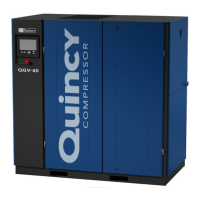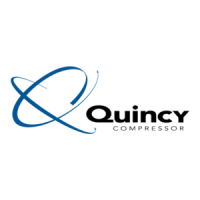Do you have a question about the Quincy Compressor QSD 65040-AB and is the answer not in the manual?
Read and follow all instructions prior to installing or operating this compressor.
Identifies hazard levels: Danger, Warning, and Caution.
Location and importance of the serial/model plate for communication.
Information on ordering genuine Quincy replacement parts.
Explanation of the model number coding system for QSD compressors.
Overview of the QSD compressor, its components, and construction.
Detailed explanation of how air is compressed in the two-stage process.
Description of water-cooled and air-cooled cooling systems for the compressor.
Explanation of the lubrication system, including pump, filter, and cooler.
Details on the function and placement of moisture separator/trap assemblies.
Explanation of Continuous Run and PowerSync II™ lift valve technology for capacity control.
Overview of the compressor's electrical system, power input, and control voltages.
Description of the backup control system for emergency operations.
List of conditions that will cause immediate shutdown of the unit.
Explanation of high air temperature (HAT) RTDs and switches for unit protection.
Description of main power light, discharge temperature, motor overload, and filter indicators.
Procedures for inspecting the compressor upon receipt and reporting damage.
Guidelines for safely moving the compressor unit using forklifts or other means.
Criteria for selecting an indoor installation site with proper ventilation and clearance.
Instructions for connecting piping, avoiding strain, and proper fit-up.
Guidance on installing manual shut-off valves for safety and maintenance.
Information on pressure relief valves, sizing, and safety standards.
Requirements for electrical supply, wiring, grounding, and protection.
Importance of guards and safety labels for preventing hazards.
Requirements for water supply and sewer connections for water-cooled models.
Procedure for checking and maintaining the fluid level using the sightglass.
Instructions for verifying correct rotation of the compressor and fan motors.
Checklist of items to verify before starting the compressor unit.
Steps for safely starting the compressor and initial observation.
Procedures for stopping the compressor during normal operation and in emergencies.
Important safety guidelines to follow while servicing the compressor.
Details on recommended compressor fluids and potential issues with mixing.
Information on fluid lifespan, draining, and fluid analysis services.
Procedures for changing fluid filters and air filter elements.
Detailed steps for replacing the input shaft seal, including special tools.
Description of the redundant shaft seal arrangement and buffing air system.
Procedure for adjusting the pressure switch settings for compressor load/unload.
Overview of the PowerSync II™ control system and its capabilities.
How to operate the compressor using the backup mode in case of electronic control failure.
Explanation of Continuous Run and Auto Dual modes for single machine operation.
Details on networking multiple compressors for coordinated operation.
Instructions for wiring compressors together to form a network.
Steps for powering up, running diagnostics, and starting the compressor.
Messages indicating sensor failures or communication problems.
Navigation of setup menus for operating parameters and maintenance.
Explanation of warning messages and conditions causing immediate unit shutdown.
List and explanation of various shutdown alarms logged by the system.
Common causes and corrective actions for compressor start-up failures.
Troubleshooting steps for issues leading to unexpected compressor shutdowns.
Diagnosing and resolving problems with low air delivery and clogged filters.
Troubleshooting excessive discharge air temperature.
Resolving issues with compressor unloading and loading functions.
Troubleshooting excessive water, pressure relief valve exhaust, and vent bowl issues.
Diagnosing and correcting thermal overload relay trips.
Troubleshooting causes for reduced air delivery pressure.
Identifying causes for elevated interstage pressure.
Diagnosing and resolving problems with network communication.
Addressing incorrect or misleading information displayed by the system.
Read and follow all instructions prior to installing or operating this compressor.
Identifies hazard levels: Danger, Warning, and Caution.
Location and importance of the serial/model plate for communication.
Information on ordering genuine Quincy replacement parts.
Explanation of the model number coding system for QSD compressors.
Overview of the QSD compressor, its components, and construction.
Detailed explanation of how air is compressed in the two-stage process.
Description of water-cooled and air-cooled cooling systems for the compressor.
Explanation of the lubrication system, including pump, filter, and cooler.
Details on the function and placement of moisture separator/trap assemblies.
Explanation of Continuous Run and PowerSync II™ lift valve technology for capacity control.
Overview of the compressor's electrical system, power input, and control voltages.
Description of the backup control system for emergency operations.
List of conditions that will cause immediate shutdown of the unit.
Explanation of high air temperature (HAT) RTDs and switches for unit protection.
Description of main power light, discharge temperature, motor overload, and filter indicators.
Procedures for inspecting the compressor upon receipt and reporting damage.
Guidelines for safely moving the compressor unit using forklifts or other means.
Criteria for selecting an indoor installation site with proper ventilation and clearance.
Instructions for connecting piping, avoiding strain, and proper fit-up.
Guidance on installing manual shut-off valves for safety and maintenance.
Information on pressure relief valves, sizing, and safety standards.
Requirements for electrical supply, wiring, grounding, and protection.
Importance of guards and safety labels for preventing hazards.
Requirements for water supply and sewer connections for water-cooled models.
Procedure for checking and maintaining the fluid level using the sightglass.
Instructions for verifying correct rotation of the compressor and fan motors.
Checklist of items to verify before starting the compressor unit.
Steps for safely starting the compressor and initial observation.
Procedures for stopping the compressor during normal operation and in emergencies.
Important safety guidelines to follow while servicing the compressor.
Details on recommended compressor fluids and potential issues with mixing.
Information on fluid lifespan, draining, and fluid analysis services.
Procedures for changing fluid filters and air filter elements.
Detailed steps for replacing the input shaft seal, including special tools.
Description of the redundant shaft seal arrangement and buffing air system.
Procedure for adjusting the pressure switch settings for compressor load/unload.
Overview of the PowerSync II™ control system and its capabilities.
How to operate the compressor using the backup mode in case of electronic control failure.
Explanation of Continuous Run and Auto Dual modes for single machine operation.
Details on networking multiple compressors for coordinated operation.
Instructions for wiring compressors together to form a network.
Steps for powering up, running diagnostics, and starting the compressor.
Messages indicating sensor failures or communication problems.
Navigation of setup menus for operating parameters and maintenance.
Explanation of warning messages and conditions causing immediate unit shutdown.
List and explanation of various shutdown alarms logged by the system.
Common causes and corrective actions for compressor start-up failures.
Troubleshooting steps for issues leading to unexpected compressor shutdowns.
Diagnosing and resolving problems with low air delivery and clogged filters.
Troubleshooting excessive discharge air temperature.
Resolving issues with compressor unloading and loading functions.
Troubleshooting excessive water, pressure relief valve exhaust, and vent bowl issues.
Diagnosing and correcting thermal overload relay trips.
Troubleshooting causes for reduced air delivery pressure.
Identifying causes for elevated interstage pressure.
Diagnosing and resolving problems with network communication.
Addressing incorrect or misleading information displayed by the system.
| Model | QSD 65040-AB |
|---|---|
| Max Pressure | 175 PSI |
| Phase | 3 |
| Drive Type | Belt Drive |
| Voltage | 460V |












